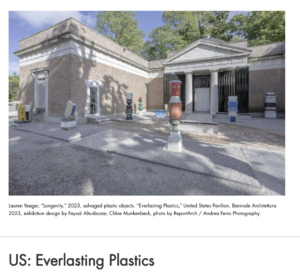Whitewall: Top Pavilions at the 18th International Architecture Exhibition in Venice
The biennale’s international architecture presentations approach climate change and the future with a sense of cautious optimism.
A recurring theme that permeates the 18th International Architecture Exhibition in Venice is a sense of cautious optimism. Climate change is a prevailing topic of discourse, and participants have approached the global environmental crisis by proposing ways in which we can try to coexist and survive as we witness the ways in which humanity has inflicted such devastation, and continue to do so. It was surprising and exciting to still see a sense of wonder and inspiration, especially at a moment in history that feels especially dark and bleak. In great part, this is a direct result of curator Lesley Lokko’s careful selection of participants. Of the 89 participants, over half are from Africa or the African Diaspora, and the gender divide is 50/50, making this one of the most diverse Venice Biennales in history, if not the most.
Many participants took Lokko’s exhibition title, “The Laboratory of the Future,” quite literally, and installed exhibitions that also acted as venues for experimentation, research, and action toward positive change.
The main exhibition is well worth your time to explore and dive deeply into, but here, Whitewall picked some of our favorite national pavilions that demonstrate the wide range of projects on view, and how they connect to the overall theme of the show and have the potential to bring forth real world, actionable change.
US: Everlasting Plastics
This year, the United States Pavilion tackles an all too present, human-made material: plastic. “Everlasting Plastics,” commissioned by Tizziana Baldenebro, SPACES’s Executive Director and co-curated by Baldenebro and Lauren Leving, Curator at the Museum of Contemporary Art Cleveland includes a wide array of works by Xavi L. Aguirre, Simon Anton, Ang Li, Norman Teague, and Lauren Yaeger that incorporate recycled and repurposed plastic material using a wide range of approaches. Rather than simply dwelling on the utter devastation that plastic has had on the environment since its popularization in the early 20th century, these artists have undertaken efforts to utilize this material in inventive and responsible ways. Each artist is given their own space at the pavilion, letting each artist’s work and approach shine both individually and collectively. We especially enjoyed the courtyard installation, which consists of a series of columnar forms by Yeager made from salvaged discarded plastic objects found around Cleveland and surrounding neighborhoods. These materials, once en route to landfills, are given new life and transformed into votive forms that bring up feelings of fond nostalgia and leave the viewer with a hopeful optimism that designers and artists will continue to think of ways to realize impressive works and simultaneously do their part in helping enact meaningful change to their environments.
By Andrew Huff
June 2, 2023


